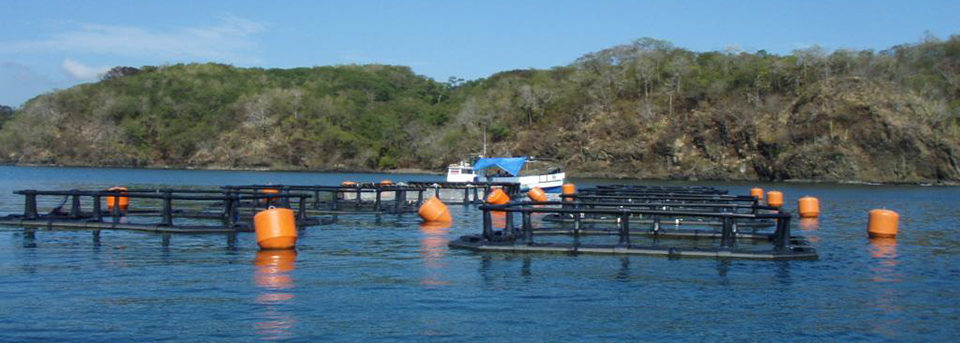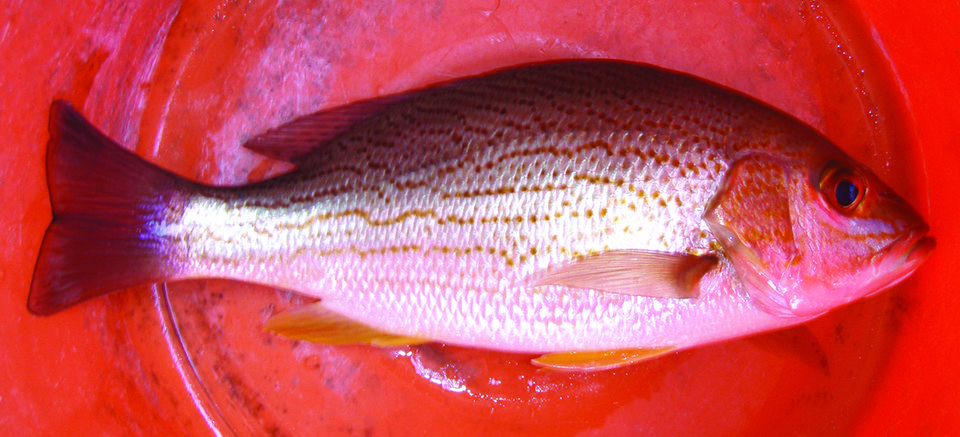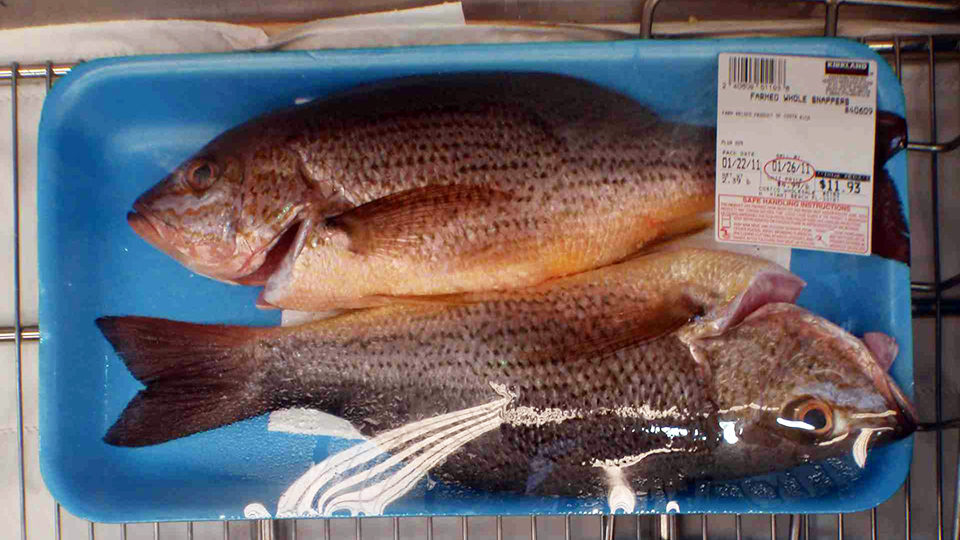Farmed product now available to U.S. consumers

Lutjanid snappers represent one of the most important finfish resources in the world. Spotted red snappers (Lutjanus guttatus) are endemic to the tropical regions of the eastern Pacific Ocean. Also known as Pacific red snappers, they are commercially and recreationally fished from Mexico to Peru.
Besides being exported primarily to the United States, spotted red snappers are much appreciated as food and part of the fishing culture of most of the Latin American countries in which they occur. The schooling fish adapt well to captivity, and the technology for closing their life cycle has been progressively developed in recent years due to the collective efforts of a number of researchers working at government institutions and in the private sector.
Interest in aquaculture
Due to their biological and market characteristics, “pargo lunarejo” or “pargo de la mancha,” as spotted red snappers are commonly known in Central America, exhibit good potential for aquaculture. Initial research conducted by Chomesmar S.A. in Costa Rica and Achotines Laboratory in Panama in the 1990s yielded positive results that included naturally and hormonally induced spawning, larval rearing, fingerling production and growout trials in cages.
Since then, interest in spotted red snappers has increased throughout the region. Several institutions – particularly Parque Marino del Pacifico in Costa Rica, the Achotnes Laboratory in Panama and Centro de Investigación en Alimentación y Desarrollo Mazatlan in Mexico – continued to conduct research projects aimed at developing protocols for the commercial production of this species.
Since 2008, methods for capture, transport, acclimation and sampling have been perfected by Martec Mariculture S.A. with technological support from and the University of Miami Aquaculture Program in Florida, USA.
The recent development of spotted red snapper aquaculture was done from the market backwards and not the other way around, as it is often the case. The snapper market is well established and thriving, with solid demand, very good prices and excellent international prospects.
The total annual aquaculture production of spotted red snappers is estimated at less than 30 mt, with the majority of fish produced by Martec. Located in Quepos on the Pacific Coast of Costa Rica, the venture is one of the largest fish processing, marketing and exporting companies in Central America.

Larval rearing
Since 2005, several larval-rearing trials were conducted at Parque Marino del Pacifico. Overall, survival rates from eggs to fingerlings have been very low, yet approximately 70,000 fingerlings – the estimated number required to stock the cages for the first production trials by Martec – were raised in 2008.
Larval-rearing methods have included intensive and mesocosm methods using traditional approaches with microalgae, rotifers and Artemia, and more innovative approaches that include natural blooms of wild plankton. Final protocols incorporate cultures of probiotics; live Isochyrsis, Nannochloropsis and Tetraselmis microalgae and microalgae pastes.
Additional measures include the enrichment of live feeds with essential nutrients, weaning diets and strict health management procedures. Prophylaxis treatments use freshwater and hydrogen peroxide, and formalin baths for eggs, larvae and broodstock.
Overcoming the bottleneck
Currently, commercial production of fingerlings is still considered the main bottleneck for the further development of large-scale snapper aquaculture operations. To this end, Martec Mariculture has established the Rancho Chico Hatchery, a state-of-the-art marine fish hatchery located in Punta Islita, Costa Rica, with the required technology and infrastructure to support commercial fingerling production.
The hatchery is stocked with eggs from both volitional, natural and hormone-induced spawnings. Selected wild and F1 broodstock fish are kept in cages and maturation rooms, as well as at Parque Marino del Pacifico as part of a collaborative agreement.
Rancho Chico Hatchery has 12, 1.5-cubic-meter tanks for incubation of eggs and first feeding stages, 12 larval-rearing tanks and four 14-cubic-meter tanks required for a consistent supply of fingerlings during the first two years. Life support systems encompass the supply of air, pure oxygen and ultraviolet-treated seawater filtered to 1 µ.
Live feed facilities consist of a microalgae laboratory and associated outdoor tanks for massive culture, one recirculating tank for rotifer production and 12, 800-L tanks for artemia hatching and enrichment. The associated infrastructure also incorporates a laboratory equipped to monitor dissolved oxygen, pH, salinity and ammonia levels.
Once mass production of the snapper fingerlings suffices to supply the requirements for the first grow-out phase – 1 million to stock five cages in 2012 and 2 million for 10 cages in 2014 – Martec plans to diversify the species raised at Rancho Chico Hatchery with other commercially important high-value marine fish species.

Grow-out
Much valuable data and knowledge regarding growth, stocking densities, feed-conversion rates and cage management have been gathered in the first nursery and grow-out cycle carried out in gravity cages at Martec Mariculture’s Gulf of Nicoya site.
In the first trial, descrbed here, the site resides in a canal formed by Cedros Island and mainland Paquera, Puntarenas. The location was selected because of its closeness to shore, protection against rough winds and waves, adequate depth and ideal currents to ensure long-term environmental sustainability.
The grow-out facility consists of eight 350-cubic-meter high-density polyethylene floating cages and a fishing boat turned headquarters. In the first trial described here, the facility yielded about 25 metric tons (MT) of fish weighing 0.45 to 0.90 kg each. The snappers showed a survival rate of 81.8 percent and feed-conversion rate of 2.4.
Feeds and feeding
Feed quality is a major issue, and researchers are still trying to determine ideal feeds and feeding practices for this snapper. To gain further knowledge about the growout of the species, the nursery and growout trials described were conducted with different stocking densities as well as varied feed ratios and types.
Initial stocking densities varied 12 to 55 juveniles per cubic meter and yielded harvest densities of 10-25 kg per cubic meter without significant differences in growth, feed conversion and survival rates. Fish were fed at ratios ranging from 2 to 7 percent of body weight utilizing feeds from national and international companies. The feed contents ranged from 55 percent crude protein and 12 percent crude fat to 44 percent protein and 10 percent fat.
Martec Mariculture is currently working with nutritionists from the University of Miami and Biomar S.A. in Chile to determine digestibility, nutritional requirements and optimal feed formulations for spotted red snappers. Martec has built a bioessay lab dedicated to running feed trials at the Rancho Chico Hatchery, and Biomar is implementing a feed plant in Costa Rica in association with AquaChile. While the primary target of the plant is the tilapia market in Costa Rica and other Central American countries, it will also answer the projected increased demand for snapper and trout feeds in the region.
(Editor’s Note: This article was originally published in the March/April 2012 print edition of the Global Aquaculture Advocate.)
Authors
-
Daniel Velarde
Martec Mariculture S.A.
Quepos, Costa Rica -
Carlos Lara
Martec Mariculture S.A.
Quepos, Costa Rica -
Marino Durán
Martec Mariculture S.A.
Quepos, Costa Rica -
Francisco Bartlett
Martec Mariculture S.A.
Quepos, Costa Rica -
Bruno Sardenberg
Martec Mariculture S.A.
Quepos, Costa Rica -

Daniel Benetti, Ph.D.
University of Miami
Rosenstiel School of Marine and Atmospheric Science
Aquaculture Program
4600 Rickenbacker Causeway
Miami, Florida 33149 USA[117,100,101,46,105,109,97,105,109,46,115,97,109,115,114,64,105,116,116,101,110,101,98,100]
Tagged With
Related Posts

Health & Welfare
Advances in intensive copepod production technology
Research at the Oceanic Institute has been successful in overcoming bottlenecks associated with rearing small-mouthed fish larvae by finding a suitable first feed. Early work on the calanoid copepod Parvocalanus crassirostris focused on parameters necessary for successful maintenance of stock cultures.

Innovation & Investment
Aquaculture Exchange: Daniel Benetti
University of Miami professor says the U.S. seafood marketplace needs to embrace 'plate-sized' fish if a domestic aquaculture industry is to become sustainable and profitable.

Aquafeeds
Aquaculture Exchange: Lukas Manomaitis, USSEC
The U.S. Soybean Export Council is a huge supporter of aquaculture growth globally, as so many aquafeed formulators rely on U.S. soy to create nutritious diets. The Southeast Asia senior technical advisor for USSEC’s aquaculture program talks about this symbiotic partnership.

Responsibility
Assessing culture potential of red emperor snapper in New Caledonia
The red emperor snapper, known as “pouatte” in New Caledonia, is valuable throughout its broad geographic range and a highly valued food fish locally. Declining wild catches and market demand have provided the incentive to carry out technical feasibility studies to determine its commercial aquaculture potential.


